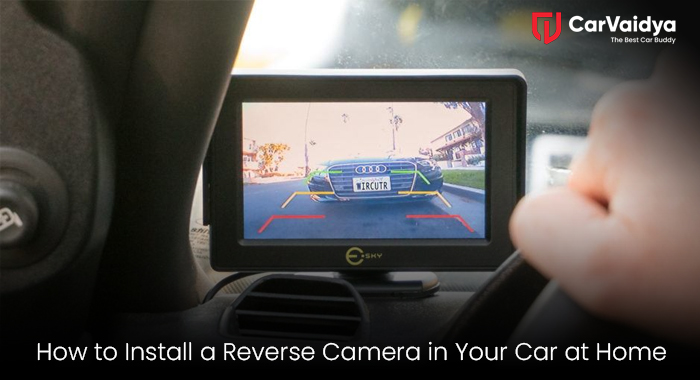Why is a Reverse Camera Important for Indian Roads?
Indian roads are crowded, parking spaces are small, and traffic is unpredictable. A reverse camera helps you park safely, avoid blind spots, and reduce the risk of accidents. Many new cars come with factory-fitted reverse cameras, but if your car doesn’t have one, you can install it yourself at home.
Types of Reverse Cameras & How to Choose the Right One
Before buying a car reverse camera, you need to know the different types:
- Fixed-Mount Cameras – Permanently installed at the rear for a steady view.
- License Plate Cameras – Attached to the number plate, making it discreet.
- Bumper-Mounted Cameras – Installed in the bumper for a clean look.
- Wireless Cameras – No wiring needed, easier installation.
- Night Vision Cameras – Infrared LEDs allow clear visibility in low light.
When buying a reverse parking camera for a car, check for resolution, viewing angle, waterproof rating, and compatibility with your car’s display.
Tools & Materials Needed for Reverse Camera Installation
To install a rearview camera for a car at home, you’ll need:
✅ Reverse camera kit (camera, wiring, and display unit if needed)
✅ Screwdrivers (flathead & Phillips)
✅ Drill (for bumper-mounted cameras)
✅ Electrical tape
✅ Wire strippers & connectors
✅Multimeter (to check wiring connections)
✅ Zip ties (to secure cables)
✅ Car manual (for wiring guidance)
Step-by-Step Guide to Installing a Reverse Camera
- Choose the Installation Spot: The best location is above the license plate or on the bumper.
- Mount the Camera: Fix it in place using screws or adhesive for a stable and clear rear view.
- Route the Wiring: Carefully pass the power and video cables from the camera to the front display unit.
- Connect the Power Supply: Identify the reverse light wire using a multimeter and connect the camera’s power cable to it. This ensures the camera turns on when you shift to reverse gear.
- Run the Video Cable: Connect the camera to the dashboard display or an external screen.
- Test the Camera: Turn on the car, shift to reverse, and check if the camera is working properly.
- Secure All Wiring: Use electrical tape and zip ties to fix the wires and prevent loose connections.
Common Mistakes to Avoid
🚫 Placing the camera at a bad angle – It should provide a clear, wide view.
🚫 Leaving wires exposed – They can get damaged and stop working.
🚫 Wrong power connection – Make sure it is connected to the correct reverse light wire.
🚫 Ignoring waterproofing – Ensure the camera is sealed properly, especially for monsoon conditions.
🚫 Skipping a test run – Always test before finalizing the installation.
Benefits of Installing a Reverse Camera in India
✔️ Increases safety – Reduces accidents due to blind spots.
✔️ Helps in parking – Makes reverse parking easy in tight spaces.
✔️ Prevents car damage – Avoids hitting curbs, poles, and other vehicles.
✔️ Boosts driver confidence – New drivers can reverse easily.
✔️ Improves resale value – A car with a reverse camera is more attractive to buyers.
DIY vs. Professional Reverse Camera Installation: Cost Comparison
💰DIY Installation: ₹2,000 – ₹5,000 (Cost of camera & tools if not available) 💰Professional Installation: ₹3,500 – ₹8,000 (Includes labor& warranty support)
If you are comfortable with basic car wiring, DIY installation can save money. But if you are unsure, get it done by a professional.
Best Reverse Camera Brands in India
Blaupunkt – High-quality and durable.
Sony – Best sensors and night vision cameras.
Autofy – Budget-friendly and easy to install.
Cartronics – Affordable and reliable.
Xenos – Offers both wired and wireless cameras.
Hikvision – Advanced car camera technology.
Installing a reverse parking camera at home is an affordable way to improve safety and convenience. By following these steps, you can easily add a rearview camera to your car. Whether you do it yourself or choose a professional service, a reverse camera is a valuable addition to make driving and parking easier in India.
For expert car repair, maintenance, and accessories installation, contact CarVaidya – Your Trusted Car Service Partner.
You can read some other articles
Understand Car Denting and Painting: Process, Inclusions & Procedure
How to Save Fuel with Smart Driving
The Most Common Car Repairs: Understanding Maintenance Needs


0 Comments